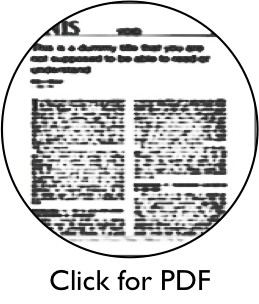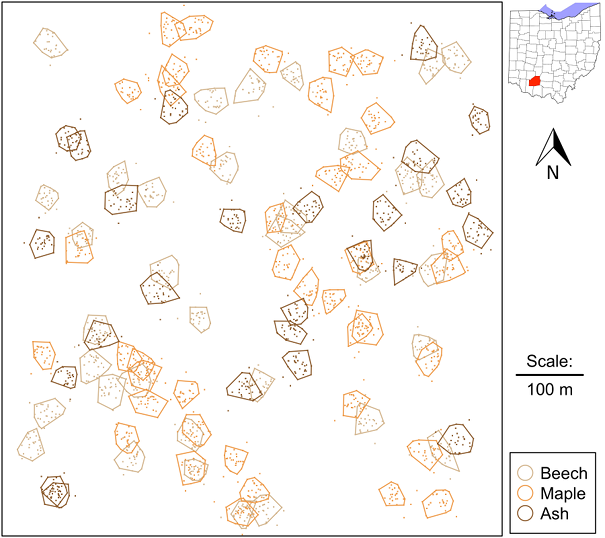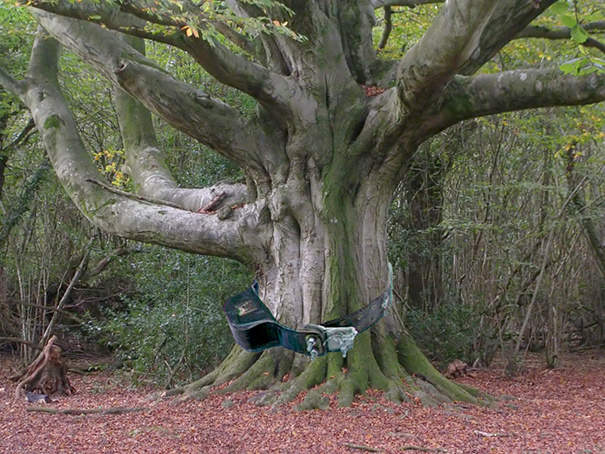
Tweet
April 9, 2015
Proceedings of the Natural Institute of Science | Volume 2 | SOFD 2
Fine-scale movements of a Midwestern Beech-Maple Forest: First Ever Tree Radiotelemetry Study
May Pullman1 and Ace R. Sackrum1
1 - Department of Forestry at the Arbor Institute of the University of Pennsylvania

Introduction
Radiotelemetry (i.e., attaching a transmitter to individuals and tracking their location with a receiver) has been an important method of observation for ecologists and conservation biologists for over 50 years. Radiotelemetry has been used to gather information on a species’ movements (e.g., Heath and Randall 1989), habitat selection (e.g., Goheen and Swihart 2005), foraging behavior (e.g., Trivelpiece et al. 1989), survival rates (e.g., Heisey and Fuller 1985), thermoregulation (e.g. Brown and Taylor 1984), and even chewing activity (e.g., Kokjer and White 1986). And it remains a popular method today (over 500 results for this year alone from a Google Scholar search of “radio telemetry species”).
Curiously, despite all of the potential information that the use of radio telemetry can provide, this technique has yet to be successfully applied to plants and, especially, trees. This oversight is especially surprising given that radiotelemetry has been used on all sorts of species including laboratory animals (Kramer and Kinter 2003), snails (e.g., Darby et al. 2002), and even insects (e.g., Kissling et al. 2014). Surely, if we can secure a radio transmitter to a bumblebee, we ought to be able to secure a transmitter to an adult tree.
Even more infuriating is that radio telemetry studies have been conducted to study animal movements within trees (Hagen and Bull 2011), the movements of tree offspring by animals (e.g., Hirsch et al. 2012), and even the effects of trees on the accuracy of radiotelemetry data (Grovenburg et al. 2013). Clearly, the use of radiotelemetry to determine the locations and movements of trees is a ripe area of research.
It is the goal of this paper to present the results of the very first successful radio telemetry study on trees (see Pullman and Sackrum unpublished data, for a non-successful attempt). We radio-tagged and tracked the movement of 100 trees in a Midwestern Beech-Maple forest for a period of two months. We were interested in analyzing the movements of trees and calculating their home ranges and survival rates. Based on previous research (Storm 2014), we hypothesized that trees would have somewhat sizable home ranges.
Methods
Equipment – One hundred radio collars were obtained from SylvatiTrak, Inc. Because the collars could not fit around the trunks of the majority of trees in our sample site, we retrofitted each transmitter onto belts (men’s small size) purchased at Wal-Mart.
Before trees were fitted with transmitters, we first tested each observer’s accuracy and precision in triangulation. A transmitter was placed on a piece of rebar in the study site at a georeferenced location (with 30 cm resolution). Each observer then determined the location of the transmitter via triangulation using a handheld 3-element Yagi antenna and a pocket compass (Suunto Inc.). Differences between the triangulated position and the actual position were then calculated. A total of 50 test fixes were obtained by each of two observers. The average difference for both observers was 21.18 m. Average error polygons were also calculated, and came out to 1202 m2 (with no difference between observers).
Attaching collars to trees – Sugar maple (Acer saccharum), American beech (Fagus grandifolia), and white ash (Fraxinus americana) individuals were sighted from a helicopter. Upon sighting, a sharpshooter fired one dart containing 100 mg/ml of Xylazine HCl, a common sedative used for large mammals, into the rump of the individual. Darts were plated with titanium in order to pierce the bark (except for American beech, in which aluminum plated darts were used). After a 5 minute waiting period, the individual tree was tracked down and processing began.
Each individual was immediately fit with a custom radio-collar (Figure 1), marked with an ear-tag (except for beech, in which we carved initials into the bark), weighed with a 50-ton Pesola Spring Scale, and cored using a Haglp Increment Borer. Half of the tree core was used for determining tree age and the other half was stored in dry ice for subsequent genetic analyses (data not shown here). After processing, an antagonist (Yohimbine HCl) was administered in order to ensure recovery of the individual from the sedative. These methods were not approved by an IACUC, because trees aren’t vertebrates.
In all, 100 individuals (40 sugar maple, 35 American beech, and 25 white ash) were collared.
Obtaining fixes – Initially, for all individuals, the transmitters emitted mortality signals one day after the transmitter was applied. We performed walk-ins for each tree and, in each instance, determined that the tree was indeed alive. We reasoned that the transmitter had malfunctioned in each case and manually disabled the mortality setting. It should be noted that this prevented us from obtaining survival rates of each population.
Tree locations were obtained every other day from June until August (battery life for the transmitters were about 8 to 10 weeks). These locations were uploaded into ArcGIS and a minimum convex polygon was used to determine home range size.
Results and Discussion
All 100 individuals were tracked for the entire two months. Locations and minimum convex polygons for all individuals are given in Figure 2.

There was substantial interspecific and intraspecific overlap between the home ranges of several tree individuals (Figure 2). An individual’s home range is the area in which an individual searches for food, while a territory is any defended area (Burt 1943) and is indicated by non-overlapping home ranges. Because we observed overlapping home ranges within and among species, we can infer that these tree species do not appear to be territorial. Because species set up territories to protect limited resources, we may also infer that many important tree resources (such as water, sunlight, mates, symbiotic relationships with cookie-baking elves, etc.) are not limited.
Average movements for all individuals were short and did not vary by species (mean ± 1 SE; sugar maple: 21.29 ± 0.25 m; American beech: 21.27 ± 0.34 m; white ash: 20.89 ± 0.54 m). These distance measurements can be converted into a minimum travelling velocity. Because we obtained telemetry fixes every other day, we can infer that the average velocity for all three tree species is around 10 m day-1.
This estimate is considerably larger than the estimates of 1 m day-1 given by previous studies on tree dispersal (Clark 1998, Feurdean et al. 2013, Ordonez and Williams 2013). Our measurements are likely more accurate because they are direct observations. Due to the perceived limited dispersal of trees, it was believed that they would not be able to keep pace with northward-shifting changes in temperature due to global climate change (estimated at 1.2 m day-1; Loarie et al. 2009). However, our estimate indicates that trees could easily migrate at a rate sufficient enough to respond to warming temperatures. And, since trees are their own habitat, they don’t have to worry about barriers to dispersal such as roads, farmland, and urban areas.
Surprisingly, average velocity did not differ significantly among the three species. We had initially hypothesized that, because of their thin bark, beech trees would be faster than ash and maple—similar to how a runner clad in spandex is faster than a runner clad in thermal underwear (see Brownlie et al. 1987). Unfortunately, this negative result prompted Under Armor© to withdraw their funding from this project.
The size of each species home range was moderate and also did not vary by species (sugar maple: 1207.57 ± 34.02 m2; American beech: 1204.51 ± 39.15 m2; white ash 1189.87 ± 58.71 m2). It should be noted that the home ranges of most individuals were similar to the error polygon generated from human error in triangulation procedures. Clearly, this suggests that future studies be conducted using more accurate equipment (e.g., satellite GPS transmitters).
Conclusions
In conducting the first every study of tree telemetry, we have uncovered several heretofore unknown characteristics of adult trees, such as the size of their home range, average minimum movement rates, and techniques for proper sedation and recovery. It is our hope that this study spurs more research into what is soon to be an emerging scientific discipline: radiotelemetree.

Proceedings of the Natural Institute of Science (PNIS) by https://instsci.org/ is licensed under a Creative Commons Attribution-ShareAlike 4.0 International License.
